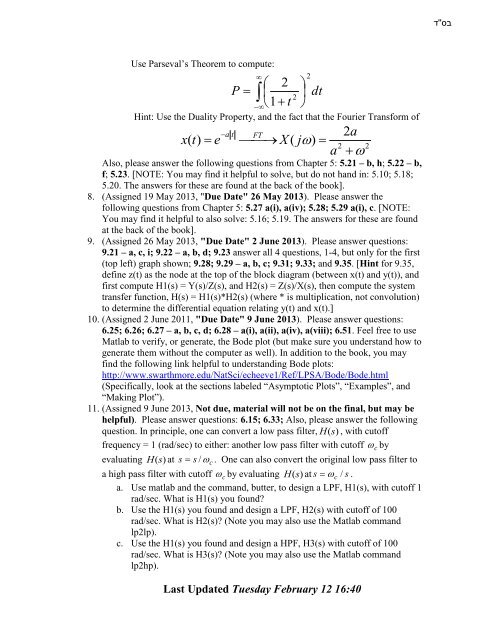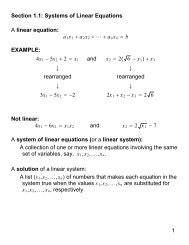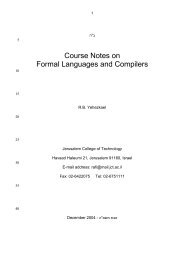Signals and Systems Homework Assignments
Signals and Systems Homework Assignments
Signals and Systems Homework Assignments
- No tags were found...
You also want an ePaper? Increase the reach of your titles
YUMPU automatically turns print PDFs into web optimized ePapers that Google loves.
בס ד''Use Parseval’s Theorem to compute:P 21tHint: Use the Duality Property, <strong>and</strong> the fact that the Fourier Transform ofx(t) e a t22dtFT X ( j)a22a2Also, please answer the following questions from Chapter 5: 5.21 – b, h; 5.22 – b,f; 5.23. [NOTE: You may find it helpful to solve, but do not h<strong>and</strong> in: 5.10; 5.18;5.20. The answers for these are found at the back of the book].8. (Assigned 19 May 2013, "Due Date" 26 May 2013). Please answer thefollowing questions from Chapter 5: 5.27 a(i), a(iv); 5.28; 5.29 a(i), c. [NOTE:You may find it helpful to also solve: 5.16; 5.19. The answers for these are foundat the back of the book].9. (Assigned 26 May 2013, "Due Date" 2 June 2013). Please answer questions:9.21 – a, c, i; 9.22 – a, b, d; 9.23 answer all 4 questions, 1-4, but only for the first(top left) graph shown; 9.28; 9.29 – a, b, c; 9.31; 9.33; <strong>and</strong> 9.35. [Hint for 9.35,define z(t) as the node at the top of the block diagram (between x(t) <strong>and</strong> y(t)), <strong>and</strong>first compute H1(s) = Y(s)/Z(s), <strong>and</strong> H2(s) = Z(s)/X(s), then compute the systemtransfer function, H(s) = H1(s)*H2(s) (where * is multiplication, not convolution)to determine the differential equation relating y(t) <strong>and</strong> x(t).]10. (Assigned 2 June 2011, "Due Date" 9 June 2013). Please answer questions:6.25; 6.26; 6.27 – a, b, c, d; 6.28 – a(i), a(ii), a(iv), a(viii); 6.51. Feel free to useMatlab to verify, or generate, the Bode plot (but make sure you underst<strong>and</strong> how togenerate them without the computer as well). In addition to the book, you mayfind the following link helpful to underst<strong>and</strong>ing Bode plots:http://www.swarthmore.edu/NatSci/echeeve1/Ref/LPSA/Bode/Bode.html(Specifically, look at the sections labeled “Asymptotic Plots”, “Examples”, <strong>and</strong>“Making Plot”).11. (Assigned 9 June 2013, Not due, material will not be on the final, but may behelpful). Please answer questions: 6.15; 6.33; Also, please answer the followingquestion. In principle, one can convert a low pass filter, H (s), with cutofffrequency = 1 (rad/sec) to either: another low pass filter with cutoff c byevaluating H(s)at s s / c. One can also convert the original low pass filter toa high pass filter with cutoff c by evaluating H(s)at s c / s .a. Use matlab <strong>and</strong> the comm<strong>and</strong>, butter, to design a LPF, H1(s), with cutoff 1rad/sec. What is H1(s) you found?b. Use the H1(s) you found <strong>and</strong> design a LPF, H2(s) with cutoff of 100rad/sec. What is H2(s)? (Note you may also use the Matlab comm<strong>and</strong>lp2lp).c. Use the H1(s) you found <strong>and</strong> design a HPF, H3(s) with cutoff of 100rad/sec. What is H3(s)? (Note you may also use the Matlab comm<strong>and</strong>lp2hp).Last Updated Tuesday February 12 16:40












